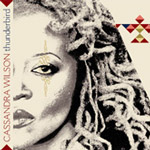Home » Jazz Articles » Profile » Cassandra Wilson: Jazz Roots
Cassandra Wilson: Jazz Roots
 Over the last two decades Cassandra Wilson has emerged as one of the most celebrated jazz singers in the world—and with one album a year since 1985, she also ranks as one of the most prolific. Because of her openness to experimentation with grooves and repertoire, Wilson's work over the years has expanded our definition of what vocal jazz is—and perhaps in some ways has called into question whether vocal jazz has any defining characteristics at all.
Over the last two decades Cassandra Wilson has emerged as one of the most celebrated jazz singers in the world—and with one album a year since 1985, she also ranks as one of the most prolific. Because of her openness to experimentation with grooves and repertoire, Wilson's work over the years has expanded our definition of what vocal jazz is—and perhaps in some ways has called into question whether vocal jazz has any defining characteristics at all.The through line to Wilson's work is the masterful application of her profoundly resonant voice to whatever musical undertaking lies before her, be it a Hank Williams tune, a free improvisation or a Miles Davis composition. Every song originates deep in her chest, close to the heart, and her performances are stripped bare of any spectacles of showmanship. You will find no wounded wailings, dramatic embellishments or abrupt exultations here. And yet her songs are packed with emotion.
There are lots of singers whose innately emotive voices drive their performances: Billie Holiday surely and, more contemporarily, Amy Winehouse, who fascinate for their ability to stand on the brink of destruction and describe the view. In her music Wilson, too, speaks truthfully about loss, not as one who threatens to succumb to it, but as one who can face it down. Thus the "Strange Fruit" she delivers on the Grammy-winning CD, New Moon Daughter (Blue Note, 1996) is not the beseeching cry for justice that Billie Holiday gave us in 1939 but rather the visceral testimony of an eyewitness. To today's listener, for whom real-life lynching is safely tucked away in history's closet, this rendition can be more shocking—and more confrontational—than Holiday's original. In this cut a resolute, but hardly resigned, Wilson begs the question, "Is history really so safely tucked away?" Thus Wilson has modernized the song's message and personalized it for a new generation of listeners.
Loverly (2008), Wilson's seventh album for Blue Note since her debut on the label in 1993 with Blue Light 'Til Dawn (a syncretic mix of pop, blues, jazz and country), is her first all-new standards recording in twenty years. The album represents a departure from the expert but more conventional treatment of standards heard on Blue Skies in 1988; this departure is as much about Wilson's artistic deepening as it is about stylistic choices.

"I needed to have an understanding of what was happening in [jazz] when it was first being born," Wilson explained. "That led me to Congo Square [in New Orleans] and thoughts about [voodoo leader] Marie Laveau, because you rarely make the connection between the voodoo ceremonies at Bayou St. John and at Congo Square and jazz. We know that that's the precursor of jazz music, but it's rare that you have people digging deep inside of that and understanding what that connection is. There's more of an emphasis I think on the marching music tradition and the European contribution to the music—which is really fascinating harmony and melodies—and they're a very important component. But what I've found in my studies through the years was that there was not as much emphasis on what happened rhythmically and what kind of invention can happen with rhythm."
Wilson brought her interest in the rhythmic origins of jazz to the table when she and Bruce Lundvall, CEO and President of Blue Note Label Group, first began discussing a standards album. "We kinda had the idea at the same time, the great idea to revisit some of that repertoire," Wilson said. The basic concept established, Lundvall gave Wilson a list of possible tunes and she worked with bassist Lonnie Plaxico to whittle down the number to those that "really resonated with me and that I could really get inside of and express." At the time, Wilson had long been working with Lekan Babalola, a Yoruba percussionist originally from Lagos, Nigeria. Babalola's expansive catalogue of rhythmic patterns proved to be the linchpin between the forgotten African roots of jazz and the album's modern American repertoire. "I had been doing a lot of work on conceptualizing the approaches and we asked the question, 'What would this music sound like if we gave it African drumming?'" Wilson said of the decision to use Yoruba percussion.
The Yoruba musical tradition is not new to North America; Yoruba sacred drumming is also part of the Cuban music of Santaria. In the West, Cubans "are the ones who probably held the Yoruba spiritual tradition. They're the ones in the Western hemisphere who are perhaps closest to it," Wilson asserts. (The only original on the album, "Arere," derives from a Yoruba song that Wilson first heard on a Cuban recording.)

For Wilson, an African American of Nigerian extraction ("if you want to call it Nigerian—those were the names that were given to those states," she points out), Yoruba percussion is as much a personal rediscovery as a musical expansion. "It was such a joy and really inspiring to work with [Lekan]. I think that as African Americans we're always searching for who we were before we came here. And when we hook up with someone like him, there is a certain recognition that happens that you can't really describe. It's such a wonderful feeling to know that not only do you have a history before you came here, but you have spiritual systems, you have art, you have culture, you have a wide array of things that you can draw on—it's like opening another door."
Also behind one of Wilson's many doors are decades of immersion in traditional American pop music—songs that revolve around the "fascinating harmony and melodies" that support the poetry of the lyrics. On Loverly Wilson does not tamper with this formula: Even on well-known tunes with non-traditional percussive lines ("Black Orpheus," "Caravan," "Till There Was You"), the groove provides the bedrock, but Wilson's soaring, clearly articulated vocals are what tower above. And of utmost importance, Wilson believes, are the lyrics, which, like the grooves she espouses, must issue from the intensely personal. "In order to deliver a piece of music, especially a piece of music that has lyrics, you have to have some sort of connection to the story behind it. Sometimes that may take years," Wilson reports, adding that "all singers will pick songs based on what their criteria are—and for me the criteria are almost always how I can tap into a song and how I can relate from experience in my life to that lyric."
But clearly Wilson does not experience the standard tunes on her new album in quite the same way as she did those on Blue Skies, where she draws from a more conventional jazz vocabulary and uses scat solos. Or perhaps her relationship to standards, the material on which she learned her craft, has changed—but there are no scats on the new disc.
"I associate scatting with bebop. And there are masters of that—Sarah Vaughan, Betty Carter, Ella Fitzgerald—who...were reflecting the music of the time. They had so much vibrancy. What the instrumentalists were doing was so fresh and new to them that of course it was a contagious kind of thing... They were in that moment. I find that what we're doing now a lot of the time with jazz is still dealing with that moment and that was the moment for that generation. So it often comes across as being too deliberate. It doesn't have the same spark that it did for that generation when they were doing it... We're experiencing that music almost second-hand."

Determined that this CD would be of its own moment, Wilson took pains to create as relaxed a recording environment as possible for her band (besides Plaxico and Babalola, guitarist Marvin Sewell, pianist Jason Moran, bassist Reginald Veal, drummer Herlin Riley and backup singer Rhonda Richmond). She chose to record the album in a house in her hometown of Jackson, Mississippi, converting the home's many rooms into a makeshift recording studio, with the control room obscured from sight. "When you walk into a studio you usually have a very strong sense of the control room—it's almost like the Wizard of Oz," Wilson explains. "So I wanted to see what it would be like if...the engineers are virtually hidden." The result, Wilson reports, was a heightened camaraderie and an enhanced conversation among the musicians—and a sense of added intimacy for the listener. At times on the recording one can hear Wilson walk toward the mic, casually, as if she were singing to herself; at other times the jingle of a bracelet, an intake of breath, a rustle of clothing—perhaps Marie Laveau is passing by.
The puzzle that Cassandra Wilson poses now is how to interpret her stylistic shifts—is she taking vocal jazz in a new direction or harkening back to its origins? Maybe these two movements are not opposed, she suggests. "I think both things are happening at once. I'm not living in that time [when jazz began] and I'm thinking about different kinds of constructs, different ways of introducing what was there a long time ago. It's new, but it involves digging deeper, going back to a time that hasn't really been acknowledged." Until now.
Selected Discography
Cassandra Wilson, Loverly (Blue Note, 2008)
Jacky Terrasson/Cassandra Wilson, Rendezvous (Blue Note, 1997)
Cassandra Wilson, Blue Light 'Til Dawn (Blue Note, 1993)
M-Base Collective, Anatomy of a Groove (DIW, 1992)
Cassandra Wilson, Blue Skies (Winter&Winter, 1988)
Air, Air Show No. 1 (Black Saint, 1986)
Photo Credits
Top Photo: John Abbott
Bottom Photo: Paolo Soriani
< Previous
Straight, No Chaser
Next >
Songs From the Heart
Comments
About Cassandra Wilson
Instrument: Vocals
Related Articles | Concerts | Albums | Photos | Similar ToTags
For the Love of Jazz
 All About Jazz has been a pillar of jazz since 1995, championing it as an art form and, more importantly, supporting the musicians who create it. Our enduring commitment has made "AAJ" one of the most culturally important websites of its kind, read by hundreds of thousands of fans, musicians and industry figures every month.
All About Jazz has been a pillar of jazz since 1995, championing it as an art form and, more importantly, supporting the musicians who create it. Our enduring commitment has made "AAJ" one of the most culturally important websites of its kind, read by hundreds of thousands of fans, musicians and industry figures every month.
























